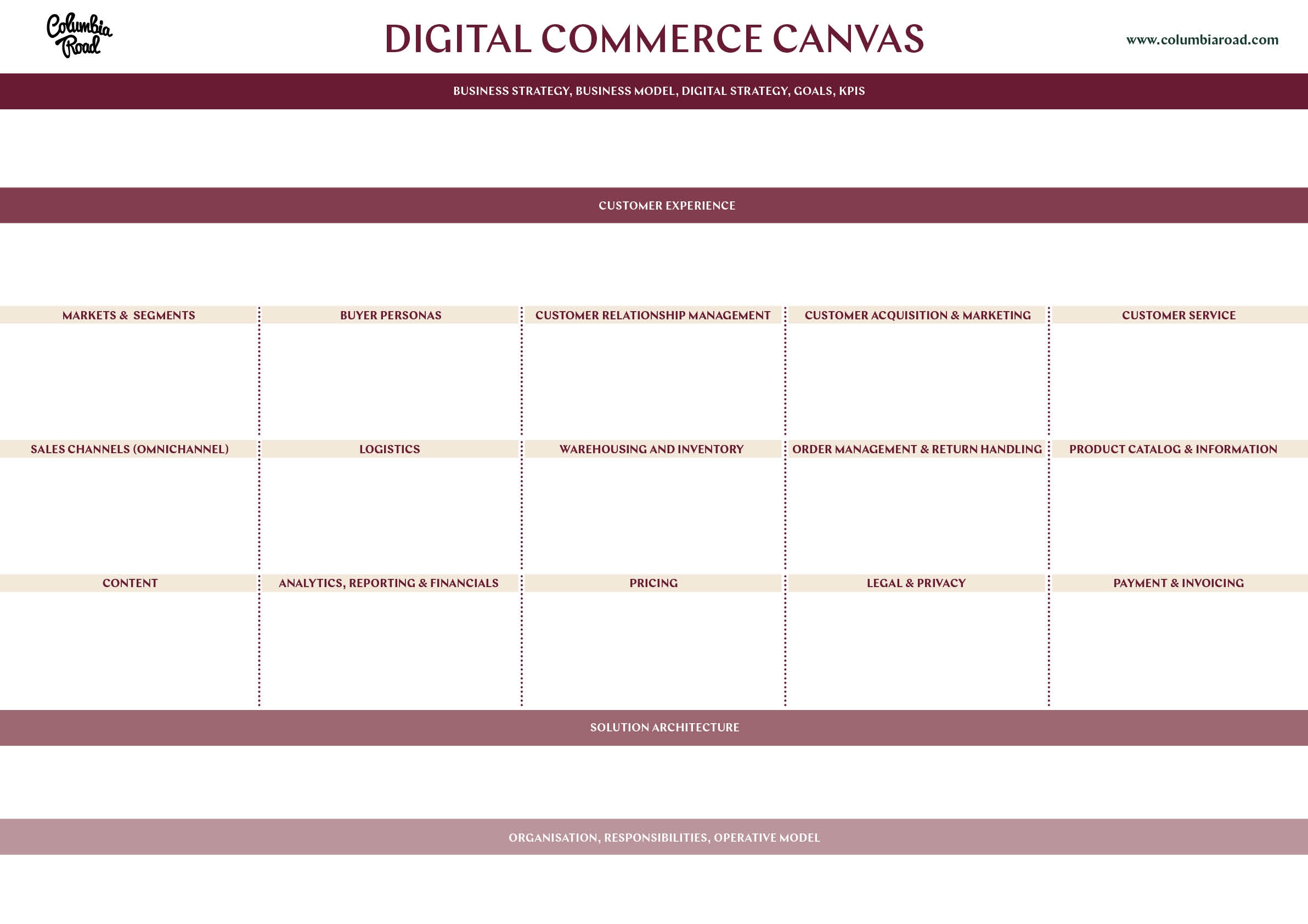The Data Handbook
How to use data to improve your customer journey and get better business outcomes in digital sales. Interviews, use cases, and deep-dives.
Get the book In this blog post we introduced the Columbia Road Digital Commerce Canvas and showed how you can use it for a holistic review of your digital commerce.
In this blog post we introduced the Columbia Road Digital Commerce Canvas and showed how you can use it for a holistic review of your digital commerce.
Now, let’s quickly go through each cell in the canvas, so that you know what is relevant in each and what are the major aspects to take into account when evaluating and revisioning your digital business.
The canvas consists of three levels, the heavy key items being in the middle. Thereby, one can state that the canvas distantly resembles a hamburger. So of course we decided to run with that metaphor. Anyway, here we go:
The bun and tasty sauce on top:
As always, you should not do any business moves without knowing the big picture and strategy - and the same goes for the Digital Commerce canvas.
You need to have defined what are the implications of business and digital strategies for your digital commerce and, the other way around: How should digital commerce enable business and digital strategies. Based on these, it’s useful to define a vision for your digital commerce, which then helps to prioritize items related to other cells and for daily operations.
Based on your strategic targets, you have to define what are the aspirations for customer experience: Should digital commerce be a highly personalized service that helps your customers to conveniently walk through their particular customer journey? Or is it enough that it’s merely a catalogue that supports customers’ decision making before and after contacting your sales representatives.
The juicy beef in the middle:
When, and only when, you know what you are aiming for with digital commerce you can evaluate and design the basic building blocks that maximize digital revenue and customer value.
The cells marked by burgundy headlines are the basic building blocks of digital commerce. There are numerous approaches to design each of them and an endless amount of components that can be applied for each. The success of your digital commerce is determined by how you define, design, and operate each of these cells. Your unique way of building the puzzle is how your digital business differs from the competitors.
Not all of the cells weigh the same in respect to effort or impact but, nonetheless, you cannot do digital commerce without having a solution for each of these. Of course, what type of business you are running affects the relevance of each of them - for example, logistics is potentially not such a big factor in service business (often it matters, though).
The key learning point? Digital sales channels, including webshop, are a major aspect of digital commerce, but they are just one key piece of the puzzle. Often our customers have been sub-optimizing this while the key wins would have been somewhere else in the canvas. For example, a webshop is worth nothing if logistics do not work.
The salad and bun that provide texture at the bottom:
The aspirations and target state for all the above should define how the two bottommost aspects are designed. However, all too often we have seen that all digital commerce discussions start with IT while the organization is a non-thought-through continuation of the needs of legacy business. On top of that, both of them are often optimized for traditional business’ operative efficiency and product orientation even though digital business is all about flexibility and long-term growth.
IT solution architecture is the growth soil of digital commerce. It has to be optimized to enable the unique digital commerce puzzle that you are aiming for, composed of the cells above. In its core, it has to be modular and flexible enough to adapt to the constantly changing needs of digital commerce. Do I have to mention that it should not bring grey hairs to the CFO?
Digital commerce affects all aspects of the business.
Finally, people and how they operate. The most simple thing to remember: You should have a digital commerce “shopkeeper” role. Secondly, digital commerce affects all aspects of the business (which is also the key message of the canvas). The great challenge is, how do you ensure that all the cross-organizational items are constantly synced and have very clear areas of responsibilities? Who should own digital commerce or should it be a horizontal matrix type of unit of its own? How to fit fast moving digital commerce with the typically slower pace of rest of the business?
Ps. Why Digital Commerce instead of eCommerce, digital business, online sales etc.? We believe that sales and customer acquisition in digital environment is not only about having a shop online. It is about aligning all the items described above, ensuring an optimized customer experience throughout the customer’s journey toward meeting her need, which then ends up in purchase and hopefully more purchases later on.
Digital Commerce can also be about direct ERP integrations with B2B clients and complex digital business models. Therefore, we think that a holistic term such as digital commerce is more fitting to the context that we are operating in.
The Data Handbook
How to use data to improve your customer journey and get better business outcomes in digital sales. Interviews, use cases, and deep-dives.
Get the book




